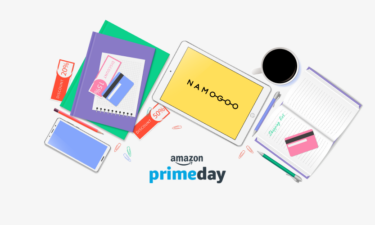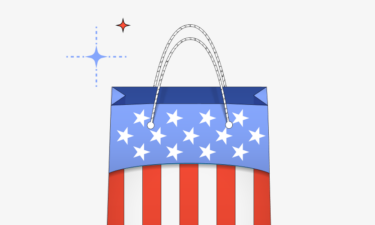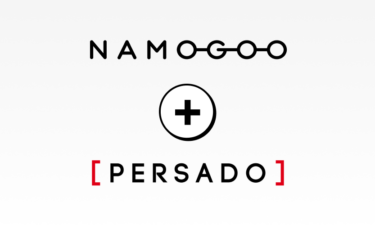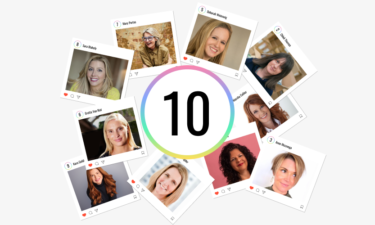Bonus Material: How to Capture the Pivotal Moments of Conversion Through Customer Intent
Personalized marketing might bring to mind things like customer segmentation, understanding your target consumer’s psychographics, and hyper-specific targeting strategies on social media.
And these are all cornerstones of personalization in marketing and advertising.
But personalized marketing spans beyond the basics of market segmentation and targeting in eCommerce. And ensuring the customer experience is tailored for each individual user you are hoping to attract is not only best practice in this new era of eCommerce; it’s expected.
In this complete guide to personalized marketing, we’ll cover everything you need to know, including:
What is Personalized Marketing?
Why Personalization is Crucial in eCommerce
Examples of Marketing Personalization (And Why They Work)
How to Start Personalizing the Customer Experience Today
Grow Your eCommerce Brand Through Personalized Marketing
What is Personalized Marketing?
Personalized marketing is a strategy where brands create a tailored experience for their audience based on the information they gather about who an individual is, including their behavior, preferences, and location.
Just like you might tell a friend or coworker about a book or product based on things you know they like, personalized marketing helps brands target, convert, and retain their most valuable customers.
Unlike traditional marketing which targets users broadly, personalized marketing tailors the experience to customers on an individual level based on specific data gathered from a variety of sources:
Brands that engage in personalized marketing then deliver a tailored customer experience based on the data collected, unique to each user.
While plenty of companies use personalized marketing, it’s particularly effective for eCommerce brands looking to stand out from the competition, and improve eCommerce team KPIs and metrics.
Why Personalization is Crucial in eCommerce
The internet is a busy place.
Between social media, email, streaming videos services, and websites, the average consumer sees more than 5,000 ads a day[*]. As a result, most internet users are learning to tune marketing messaging out and digital marketing strategies like paid ads are becoming less effective.
Personalization helps breakthrough “ad blindness” by delivering customized offers, messaging, and creative that consumers actually care about.
It is incredibly effective for eCommerce brands, with 61% of online shoppers surveyed stating they would be more likely to buy from a personalized offer that is customized to their needs and interests.
Established, savvy online retailers understand this, too.
We surveyed 100 senior eCommerce executives in the US and beyond, all of whom work in companies with online annual revenues ranging from $15M to $1B and more, and 55% cited improving onsite personalization as a top priority for increasing eCommerce revenue.
Not sold yet? Here are a few more reasons why personalized marketing is crucial for eCommerce growth.
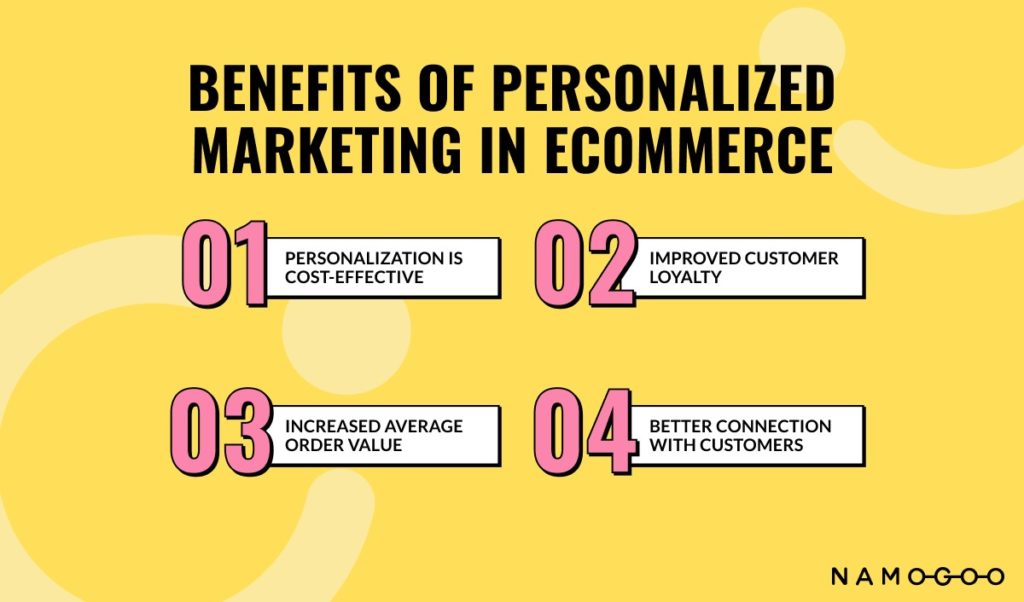
#1. Personalized Marketing is Cost-Effective
Personalized marketing tends to be more effective, but it also costs brands less, too. Recent studies found using personalization can reduce acquisition costs by as much as 50% and increase marketing spend efficiency by 30%[*].
So while you might spend a bit more setting up and launching a personalization campaign, your ad spend will go further in the long run. However, personalization is not a silver-bullet strategy; it should be part of a multi-channel marketing strategy that draws customers in and keeps them coming back for more.
#2. Customers Spend More With Personalized Marketing
Personalized offers and campaigns provide targeted offers to customers based on their past browsing behavior and other personal data. This makes the offers far more relevant, increasing sales by offering customers items they are most likely to be interested in.
In fact, nearly half of all shoppers report making an impulse purchase after receiving a personalized recommendation from a brand[*]. More than 20% of shoppers say they spent more than $50 on a single purchase from a personalized offer, and 7% spend more than $100. Even more impressive, 85% of impulse shoppers were satisfied with their purchase, with just 5 % of shoppers returning their items.
This means in addition to increasing eCommerce sales as a whole, personalization increases customer lifetime value and average order value.
#3. Personalization Drives Customer Loyalty
It’s cheaper to keep the customers you have than to attract new customers, and personalization helps brands do just that.
Personalized marketing provides consumers with a personal connection, which was long a part of traditional shopping in places like markets and department stores. While eCommerce shoppers have far more options today, many still want that personal touch.
People are becoming more accustomed to the customer personalization they receive in their social media news feeds and on sites like Amazon. Delivering exclusive campaigns and personally suggested products gives customers the personal experience they crave and can drive loyalty.
#4. Individualization Creates a More Personal Connection
Today’s eCommerce experience is not just about transactions; it’s about relationships.
With so many options and competitors, you can’t win just by creating products and launching your store. To be competitive, stores need to humanize their brand and find ways to develop deeper connections.
Personalized marketing shows customers you care about them on a personal level. That connection can help you build a stronger connection for months and years to come.
Examples of Marketing Personalization (And Why They Work)
Consumers have a nearly unlimited number of options, which can be overwhelming. Personalized marketing aims to make the buying experience easy and limit options so consumers can finish their purchase and get back to their lives.
Many points in the customer journey offer potential for personalization, including videos, landing pages, homepages, ads, emails, push notifications, product and service recommendations, and transactional messages, such as receipts and shipping notifications.
So how does personalization look in action? Let’s look at a few examples and explore why they work.
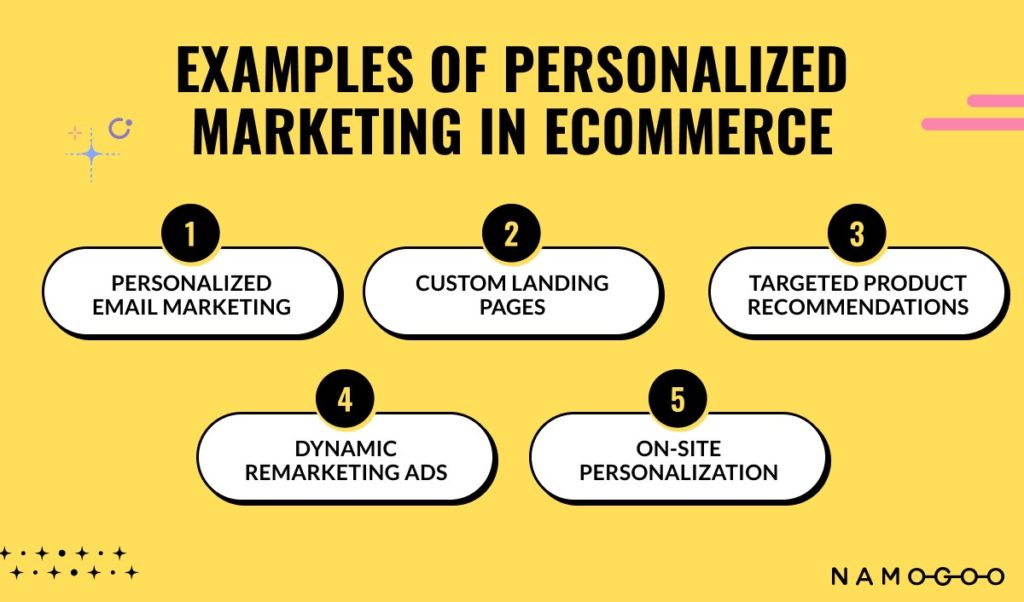
#1. Personalization in Email Marketing
Emails are the OG of personalized marketing — brands have been using consumers’ names in emails for years. Today, however, personalization goes much further. Targeted email campaigns can be created based on user behavior, location, industry, and more.
For example, Suiteness sends travelers a personalized email recounting where they’ve traveled in the last year and how long they’ve been with the brand.

In addition to reminding the customer of the great times they’ve had, the brand also delivers a discount code to encourage another transaction.
#2. Custom Landing Pages
Static homepages and landing pages offer a broad experience designed to attract as many visitors as possible to continue their path through the sales funnel. The problem is, not all visitors are looking for the same solutions.
Creating a dynamic and personalized homepage or landing page allows the content to change based on user behavior — and these outperform static pages nearly every time.
For example, Worldwide Airlines uses a targeted home page based on past visitor behavior. A new site visitor sees a standard page where they can book a flight or check on their trips.

While a visitor who has expressed interest in traveling to Dubai sees a personalized homepage featuring images and copy related to Dubai.

This small amount of customization shows visitors the site is paying attention to their needs and makes it easier for them to complete their purchase.
#3. Personalized Product Recommendations
Today’s shoppers expect personalized recommendations.
Sites like Amazon, Netflix, and Hulu adapt their recommendations based on the user’s past behavior. This allows brands to recommend higher profit-margin items, share related items, and drive consumers to buy.
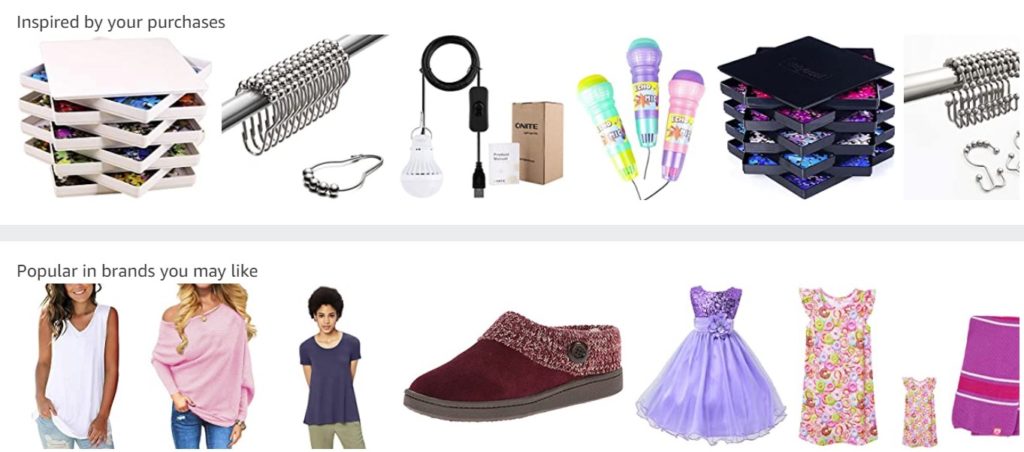
Amazon offers several rows of product recommendations, based on related products, shopping trends, stores the user has shopped at, and popular brands. When shoppers head to their Amazon homepage, they’re greeted by a full page of personalized recommendations.
#4. Dynamic Retargeting Ads
Dynamic retargeting ads show ads to site visitors based on past behavior. For example, after searching for a new dress and viewing an ad from a jumpsuit by Vuori, this ad displayed on my Facebook page:

It is a small ad that keeps the brand top of mind and encourages me to complete the purchase.
Showing ads for items shoppers have already expressed interest in is an abandoned cart recovery strategy that most eCommerce teams are doing anyway.
#5. Personalized Customer Experience Onsite
It’s not enough to leave the personalization to your email marketing messages and ad targeting.
One of the most effective ways to convert website visitors into loyal customers is by tailoring the customer experience, including the promotions offered, to each individual customer based on their behaviors and customer intent.
Why?
Because some customer segments are more likely to convert when incentivized with a sales promotion, whereas others have high intent to purchase and don’t need an incentive to complete their order.
Treating all of your site visitors the same will lead to:
- Lost revenue
- Eroded margins
- Damaged brand perception as you train your customers to expect a discount.
In the past, it was nearly impossible to tailor promotions to each individual customer, but machine learning and AI have opened doors and empowered even small eCommerce brands to engage in intent-based marketing.
Resource Guide: Intent-Based Marketing
Powerful tools like Intent-Based Promotions help to serve a one-to-one customer onsite experience that is personalized specifically to each individual visitor.
It works by calculating shoppers’ purchasing patterns and intent to determine the right offer for each specific customer during their session, based on behavioral and intent signals:

This enables a personalized customer onsite experience that leads to:
- Improved conversion rates
- Increased average order value
- Reduced cart abandonment
- Protected brand perception
- Improved margins.
Presenting promotions only to those who require one to convert not only drives conversion rates and revenue but also protects your margins by reducing the average discount rate.
For example, this Namogoo customer set their maximum discount in Intent-Based Promotions at 15% but averaged only 5.2% for the week.
This helped them save $17,000+ in margin across 117 orders for the week.
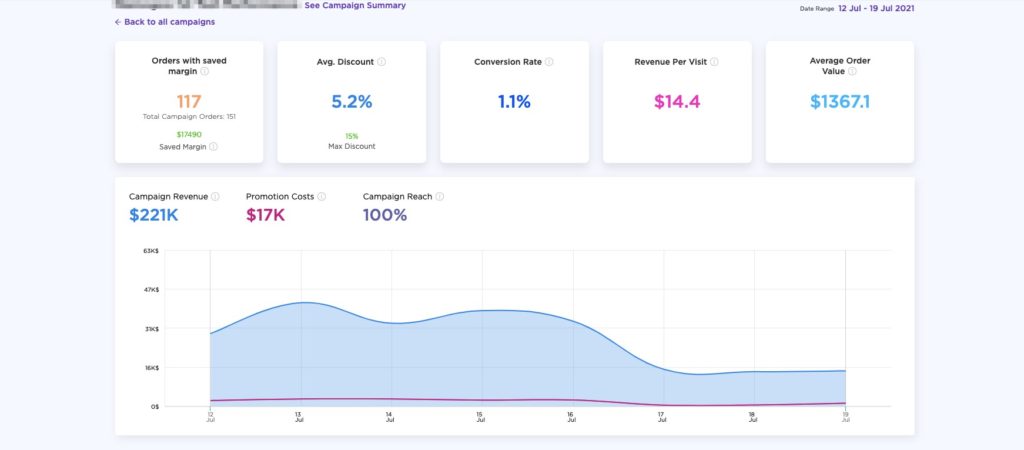
Ensuring your customers are offered the minimum promotion required to convert not only personalizes the experience for the customer but also protects your eCommerce profitability.
How to Start Personalizing the Customer Experience Today
Now that you know what marketing personalization is and why it’s crucial for eCommerce companies, let’s talk about how to put it into practice. Here’s a five-step guide to creating your personalization strategy.
Set a Personalization Strategy Goal
Personalization efforts should be customized based on your eCommerce goals. If brand awareness is the goal, then demographic targeting may be the most effective strategy. If your goal is increasing sales, then consider using behavioral personalization data.
In general, the closer your goal is to conversion, the more specific you’ll want to target. For example, if your goal is to increase customer orders, consider using product recommendations based on previous purchases or dynamic ads.
Here are a few goals to consider personalization:
- Increase sales
- Drive loyalty
- Increase brand awareness
- New product launch
- Recover abandoned carts
Keep in mind, getting too granular with targeting early in the funnel can reduce ROI and cut you off from audiences that might convert.
Gather Data
Once you’ve outlined a goal for your personalized marketing campaign (or several, if you are testing multiple campaigns), it is time to start gathering data. Make sure to notify customers you are collecting data and ensure the data is secure.
What type of data should you collect? Based on your goals, you might collect:
- Demographic: Age, location, income level, gender, etc.
- Preferences: These can vary based on industry. A clothing store might store preferred sizes, while a craft store might track the types of crafts shoppers are interested in.
- Site Behavior: Track page views, time on pages, downloads, and any other actions that tell you who customers are and what they want.
- Current or New Customers: New and returning customers have different needs, so you might want to track if they’ve shopped with you before or not.
Consider using tools like Adobe Target, Google Optimize, and Logic Hop to collect data for your campaigns. Customer surveys can also be useful.
Outline Key Customer Personas
Personas help brands craft messaging that appeals to specific customers. With clearly defined customer personas, you’ll understand who, how, and where your campaigns will achieve the greatest success.
Consider creating personas based on:
- Demographics
- Shopping patterns
- Site behavior
- Platforms they use
- First time visitors vs repeat customers
- Industry
- Income level
Keep in mind, customer persona building is a process that should be repeated regularly basis. Over time, customers change, preferences shift, and new trends emerge. To stay effective, consider updating personas annually.
Create Personalized Campaigns
You have a goal, you know who your customers are; it is time to create your personalized campaigns. The tools we mentioned for data collection (Adobe Target, Google Optimize, and Logic Hop) can also help you create your campaigns.
Here are a few tips to ensure success with personalized marketing:
- Aim For Helpful, Not Creepy: Most users don’t see personalization as creepy, but coming on too strong can be a turn off. Aim to be helpful by providing customers with links and information they are likely to enjoy, but don’t refer to specific actions they’ve taken.
- Consider Each Stage of the Customer Journey: Personalization works across the customer journey. However, each stage requires a different approach. Buyers earlier in the funnel are likely to respond to gentle nudges, while those who are ready to buy may respond to more direct contacts, like emails or ads mentioning specific products they’ve viewed.
- Use Dynamic Landing Pages: Dynamic landing pages personalize their content based on the user. For example, a travel site might mention a past or planned trip the customer plans to take, or a Facebook ad might take the user to a landing page focusing on the category of products or services they viewed.
- Be Clear About Data Collection: Online security is more important than ever. To stay on your customer’s good side (and the right side of regulations), make sure to get permission to gather data and keep it secure.
Test
Once you have launched campaigns, you’ll want to understand what is working and what doesn’t. That is where A/B testing comes in. A/B testing allows brands to try out different versions of personalized campaigns to see which is most effective.
There is a nearly unlimited number of tests you can run. For example, you might find customers respond better to a personalized ad on Facebook within an hour of viewing an item but respond to emails when delivered a day later.
Not sure what to test? Here’s a few A/B test to try out:
- Timing
- Ad copy
- Platform delivery
- Above the fold vs below the fold personalization
- Demographics
The goal of A/B testing is to find the most effective way to reach your customers. This might mean testing several iterations of a landing page, for example, then testing both a static and personalized page.
Grow Your eCommerce Brand Through Personalized Marketing
The key to personalized marketing is relevance. eCommerce brands that use personal data to understand their audience and create relevant campaigns are likely to be rewarded with:
- Reduced acquisition costs
- Lower ad spend
- Higher sales
- Higher customer LTV
Now it’s time to start gathering data and put it to use for your personalized eCommerce campaign.





